
Tkinter标准库
Tkinter是Python的标准GUI库,也是最常用的Python GUI库之一,提供了丰富的组件和功能,包括窗口、按钮、标签、文本框、列表框、滚动条、画布、菜单等,方便开发者进行图形界面的开发。Tkinter库基于Tk for Unix/Windows/macOS,由Tcl语言编写。使用Tkinter,可以快速创建桌面应用程序,并支持多平台Windows、macOS、Linux等。
tkinter控件全集
在python中导入tkinter库后,有18种控件(也称组件):
导入方式:import tkinter as tk
Button、Canvas、Checkbutton、Entry、Frame、Label、LabelFrame、Listbox、Menu、Menubutton、Message、OptionMenu、PanedWindow、Radiobutton、Scale、Scrollbar、Spinbox、Text
最学见的按钮、文本框、标签、列表框等都在里边,唯独没看到组合框ComboBox。查过资料后才知道,tkinter库中还有一子模块tkinter.ttk,它包含有包括Combobox在内的20种控件:
导入方式:from tkinter import ttk
Button、Checkbutton、Combobox、Entry、Frame、Label、LabelFrame、LabeledScale、Labelframe、Menubutton、Notebook、OptionMenu、PanedWindow、Progressbar、Radiobutton、Scale、Scrollbar、Separator、Sizegrip、Spinbox、Treeview
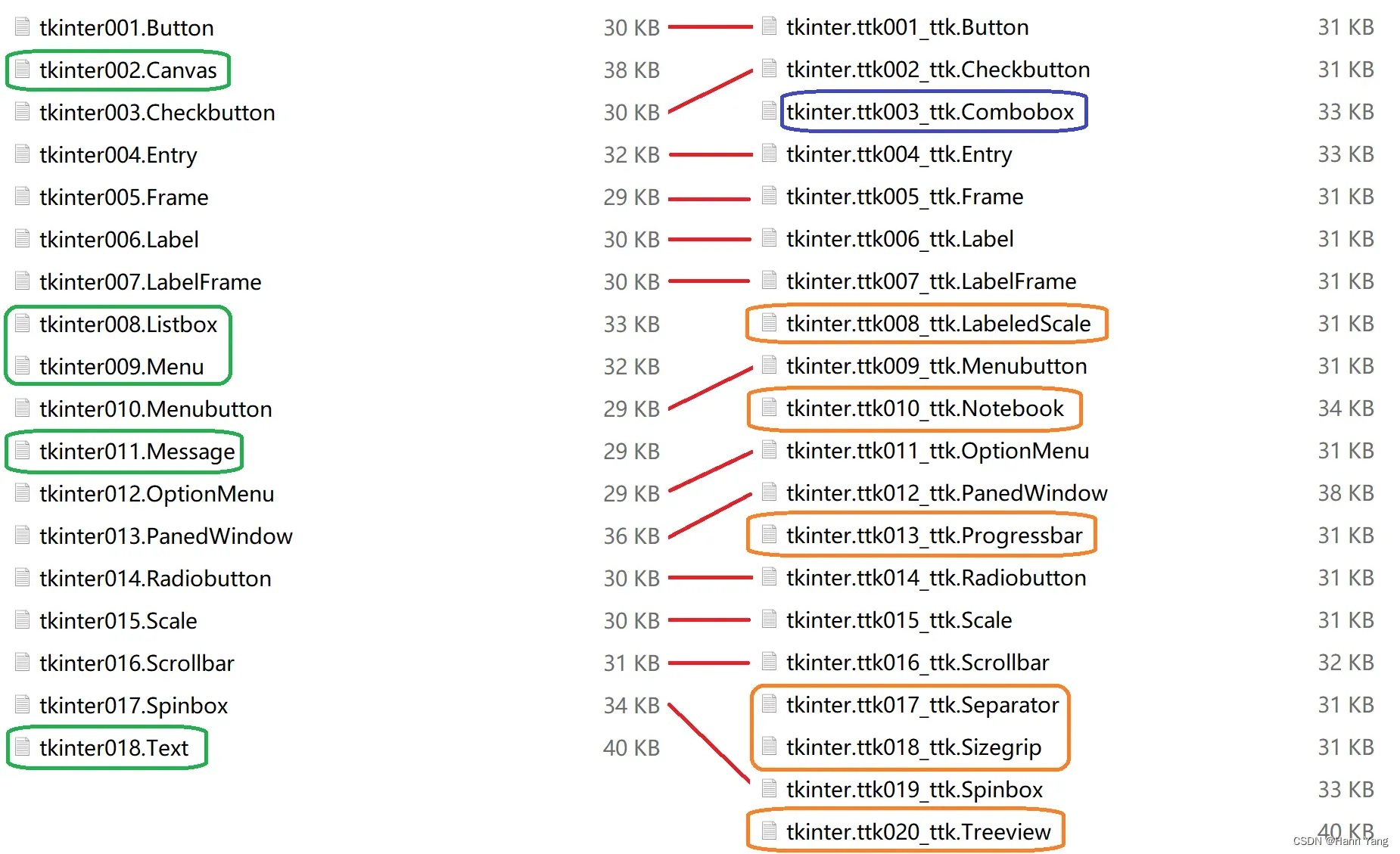
请注意,某些控件在两个模块中都存在(如Button, Checkbutton, Entry等),但它们在外观和行为上可能会有所不同,ttk模块中的控件可以提供更加现代和可定制的外观。以Button为例,都以简单的方式表达,运行后的外观和行为都有些不同。
import tkinter as tk
from tkinter import ttk
button1 = tk.Button(root, text=”Click Me”, command=button_click)
button2 = ttk.Button(root, text=”Click Me”, command=button_click)
如图所示:
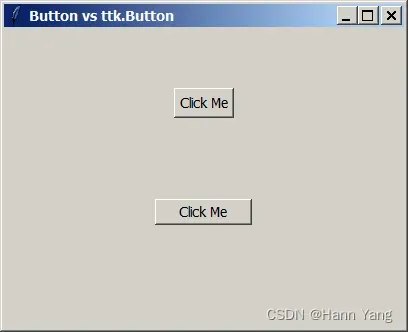
完整代码如下:
import tkinter as tk
from tkinter import ttk
def button_click():
print("Button clicked!")
if __name__=='__main__':
root = tk.Tk()
root.title("Button vs ttk.Button")
root.geometry("400x300")
button1 = tk.Button(root, text="Click Me", command=button_click)
button1.pack(pady=60)
button2 = ttk.Button(root, text="Click Me", command=button_click)
button2.pack(pady=20)
root.mainloop()以下将介绍今天的主角:ttk.Combobox 组合选择框。
ComboBox 组合选择框
ComboBox 将几个文本字段组合成为一个可弹出的选择列表。它的原版帮助有3万多字呢,以下挑一些主要的操作方法简单介绍一下:
创建并设置选择项
values = [“Option 1”, “Option 2”, “Option 3”, “Option 4”]
combobox = ttk.Combobox(root, values=values)
combobox.pack()
绑定事件ComboboxSelected
combobox.bind(“<<ComboboxSelected>>”, on_select)
获取当前选择项combobox.get()
combobox.get()
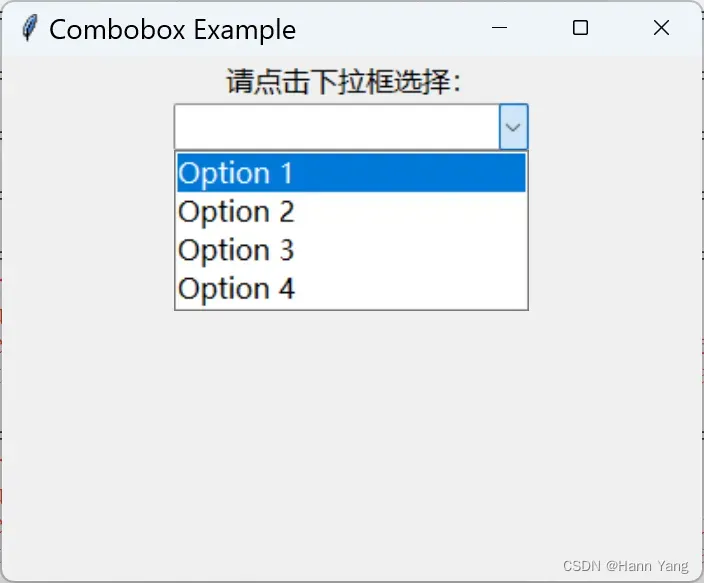
以上插图的代码如下:
import tkinter as tk
from tkinter import ttk
def on_select(event):
label.config(text = "当前选择为:" + combobox.get())
if __name__=='__main__':
# 创建主窗口
root = tk.Tk()
root.title("Combobox Example")
root.geometry("400x300")
label = tk.Label(root, text="请点击下拉框选择:")
label.pack()
# 创建多选下拉框
values = ["Option 1", "Option 2", "Option 3", "Option 4"]
combobox = ttk.Combobox(root, values=values)
combobox.pack()
combobox.bind("<<ComboboxSelected>>", on_select)
# 运行主循环
root.mainloop()设置当前显示项combobox.set()
combobox.set()
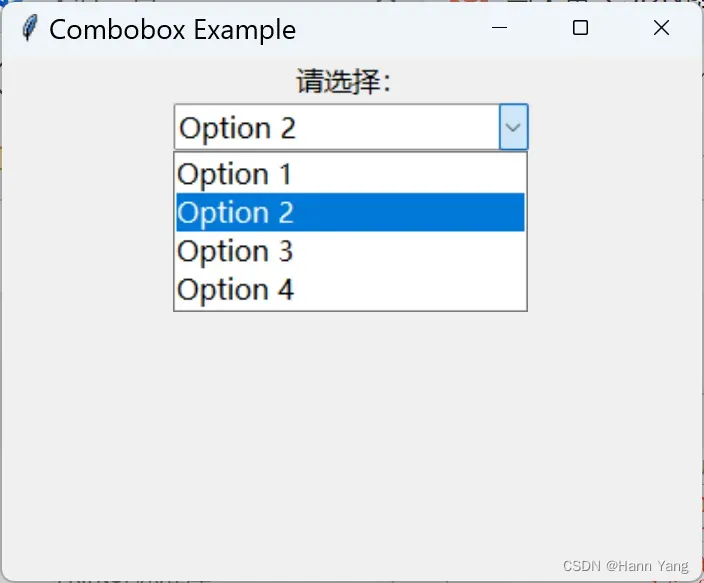
自定义类 SelectCombobox
把以上内容综合起来,自定义一个组合框类:
import tkinter as tk
from tkinter import ttk
class SelectCombobox(ttk.Combobox):
def __init__(self, master=None, values=None):
super().__init__(master, values=values)
self.bind("<<ComboboxSelected>>", self.on_select)
def on_select(self, event):
label.config(text = "当前选择为:" + self.get())
if __name__=='__main__':
# 创建主窗口
root = tk.Tk()
root.title("Combobox Example")
root.geometry("400x300")
label = tk.Label(root, text="请点击下拉框选择:")
label.pack()
# 创建多选下拉框
values = ["Option 1", "Option 2", "Option 3", "Option 4"]
combobox = SelectCombobox(root, values=values)
combobox.pack()
# 运行主循环
root.mainloop()扩展Combobox组合框
拓展成多项选择
Combobox本身不支持多项选择,变通方法:引入一个列表,用于存放已选项,奇数次选择一个项则存入列表、反之偶数次选择则移除。
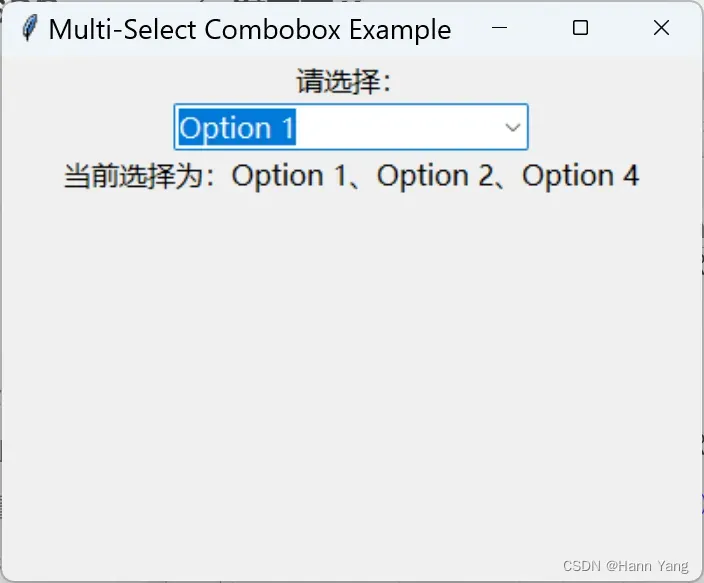
代码如下:
import tkinter as tk
from tkinter import ttk
class MultiSelectCombobox(ttk.Combobox):
def __init__(self, master=None, values=None, **kwargs):
super().__init__(master, values=values, **kwargs)
self.bind("<<ComboboxSelected>>", self.on_select)
self.selected_values = []
def on_select(self, event):
selected_value = self.get() # 使用 get 方法获取选中项的值
if selected_value in self.selected_values:
self.selected_values.remove(selected_value) # 如果已选中,则移除该选项
else:
self.selected_values.append(selected_value) # 如果未选中,则添加到已选项列表
self.selected_values.sort()
if self.selected_values:
text = '、'.join(self.selected_values)
else:
text = '空'
label2.config(text = "当前选择为:" + text)
if __name__=='__main__':
# 创建主窗口
root = tk.Tk()
root.title("Multi-Select Combobox Example")
root.geometry("400x300")
label = tk.Label(root, text="请选择:")
label.pack()
# 创建多选下拉框
values = ["Option 1", "Option 2", "Option 3", "Option 4"]
combobox = MultiSelectCombobox(root, values=values)
combobox.pack()
text = "当前选择为:空"
label2 = tk.Label(root, text=text)
label2.pack()
# 运行主循环
root.mainloop()
选项前添加符号
Combobox本身不支持修改选择项,变通方法:在每次变更选项时都重建一个新的组合框,同时把所有的选项前都加上一个全角空格(\u3000),对于已选中的选项,则把前面的全角空格替换成对勾符号(\u2713)。
这样子可能更像一个多项选择框,如下图:
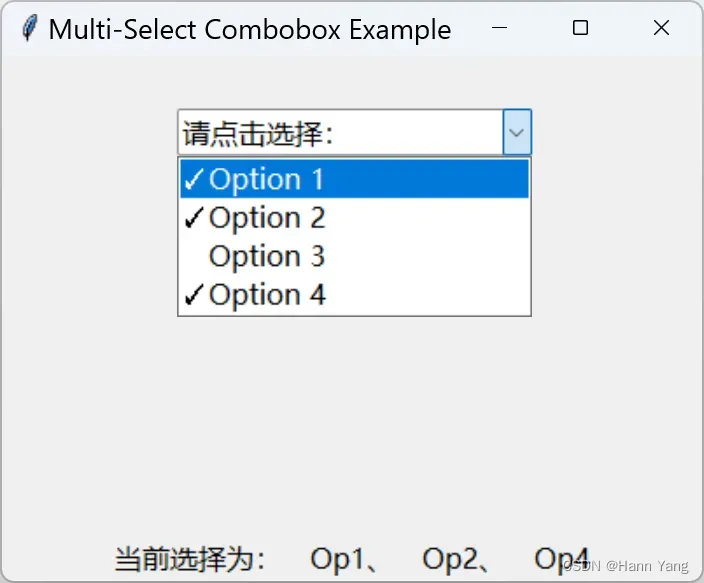
代码如下:
import tkinter as tk
from tkinter import ttk
def on_select(event):
selected_value = combobox.get()
selected_value = selected_value.replace("\u2713","\u3000")
if selected_value in selected_values:
selected_values.remove(selected_value)
else:
selected_values.append(selected_value)
selected_values.sort()
if selected_values:
text = '、'.join(selected_values).replace('tion ','')
else:
text = '空'
label.config(text = "当前选择为:" + text)
update_combobox_options()
def update_combobox_options():
global combobox
combobox.grid_forget()
new_values = []
for v in values:
if v in selected_values:
new_values.append(v.replace("\u3000","\u2713"))
else:
new_values.append(v)
combobox = ttk.Combobox(root, values=new_values, state='readonly')
combobox.place(x=100, y=30)
combobox.set('请点击选择:')
combobox.bind("<<ComboboxSelected>>", on_select)
if __name__=='__main__':
# 创建主窗口
root = tk.Tk()
root.title("Multi-Select Combobox Example")
root.geometry("400x300")
# 创建多选下拉框
values = ["Option 1", "Option 2", "Option 3", "Option 4"]
values = ["\u3000"+v for v in values]
selected_values = []
combobox = ttk.Combobox(root, values=values, state='readonly')
combobox.place(x=100, y=30)
combobox.set('请点击选择:')
combobox.bind("<<ComboboxSelected>>", on_select)
text = "当前选择为:空"
label = tk.Label(root, text=text)
label.pack(side=tk.BOTTOM)
# 运行主循环
root.mainloop()题外话
以上这些是我自己瞎写的变通代码,可能有更好的办法来实现这些功能,也有可能ttk模块本身就有这些功能,只是我没发现而已。另外:如果选择项不至是四个而是有很多,最好能在最前面设置两个选项,全部选择和取消全选,它们不参与进入已选项列表,点击它们只为在其它选项上标注对勾同时填满或清空已选项列表。感兴趣的朋友,可以自己动手实现这两个功能。
附件一
Combobox 英文帮助
Help on class Combobox in module tkinter.ttk:
class Combobox(Entry)
| Combobox(master=None, **kw)
|
| Ttk Combobox widget combines a text field with a pop-down list of values.
|
| Method resolution order:
| Combobox
| Entry
| Widget
| tkinter.Entry
| tkinter.Widget
| tkinter.BaseWidget
| tkinter.Misc
| tkinter.Pack
| tkinter.Place
| tkinter.Grid
| tkinter.XView
| builtins.object
|
| Methods defined here:
|
| __init__(self, master=None, **kw)
| Construct a Ttk Combobox widget with the parent master.
|
| STANDARD OPTIONS
|
| class, cursor, style, takefocus
|
| WIDGET-SPECIFIC OPTIONS
|
| exportselection, justify, height, postcommand, state,
| textvariable, values, width
|
| current(self, newindex=None)
| If newindex is supplied, sets the combobox value to the
| element at position newindex in the list of values. Otherwise,
| returns the index of the current value in the list of values
| or -1 if the current value does not appear in the list.
|
| set(self, value)
| Sets the value of the combobox to value.
|
| ———————————————————————-
| Methods inherited from Entry:
|
| bbox(self, index)
| Return a tuple of (x, y, width, height) which describes the
| bounding box of the character given by index.
|
| identify(self, x, y)
| Returns the name of the element at position x, y, or the
| empty string if the coordinates are outside the window.
|
| validate(self)
| Force revalidation, independent of the conditions specified
| by the validate option. Returns False if validation fails, True
| if it succeeds. Sets or clears the invalid state accordingly.
|
| ———————————————————————-
| Methods inherited from Widget:
|
| instate(self, statespec, callback=None, *args, **kw)
| Test the widget’s state.
|
| If callback is not specified, returns True if the widget state
| matches statespec and False otherwise. If callback is specified,
| then it will be invoked with *args, **kw if the widget state
| matches statespec. statespec is expected to be a sequence.
|
| state(self, statespec=None)
| Modify or inquire widget state.
|
| Widget state is returned if statespec is None, otherwise it is
| set according to the statespec flags and then a new state spec
| is returned indicating which flags were changed. statespec is
| expected to be a sequence.
|
| ———————————————————————-
| Methods inherited from tkinter.Entry:
|
| delete(self, first, last=None)
| Delete text from FIRST to LAST (not included).
|
| get(self)
| Return the text.
|
| icursor(self, index)
| Insert cursor at INDEX.
|
| index(self, index)
| Return position of cursor.
|
| insert(self, index, string)
| Insert STRING at INDEX.
|
| scan_dragto(self, x)
| Adjust the view of the canvas to 10 times the
| difference between X and Y and the coordinates given in
| scan_mark.
|
| scan_mark(self, x)
| Remember the current X, Y coordinates.
|
| select_adjust = selection_adjust(self, index)
|
| select_clear = selection_clear(self)
|
| select_from = selection_from(self, index)
|
| select_present = selection_present(self)
|
| select_range = selection_range(self, start, end)
|
| select_to = selection_to(self, index)
|
| selection_adjust(self, index)
| Adjust the end of the selection near the cursor to INDEX.
|
| selection_clear(self)
| Clear the selection if it is in this widget.
|
| selection_from(self, index)
| Set the fixed end of a selection to INDEX.
|
| selection_present(self)
| Return True if there are characters selected in the entry, False
| otherwise.
|
| selection_range(self, start, end)
| Set the selection from START to END (not included).
|
| selection_to(self, index)
| Set the variable end of a selection to INDEX.
|
| ———————————————————————-
| Methods inherited from tkinter.BaseWidget:
|
| destroy(self)
| Destroy this and all descendants widgets.
|
| ———————————————————————-
| Methods inherited from tkinter.Misc:
|
| __getitem__ = cget(self, key)
|
| __repr__(self)
| Return repr(self).
|
| __setitem__(self, key, value)
|
| __str__(self)
| Return the window path name of this widget.
|
| after(self, ms, func=None, *args)
| Call function once after given time.
|
| MS specifies the time in milliseconds. FUNC gives the
| function which shall be called. Additional parameters
| are given as parameters to the function call. Return
| identifier to cancel scheduling with after_cancel.
|
| after_cancel(self, id)
| Cancel scheduling of function identified with ID.
|
| Identifier returned by after or after_idle must be
| given as first parameter.
|
| after_idle(self, func, *args)
| Call FUNC once if the Tcl main loop has no event to
| process.
|
| Return an identifier to cancel the scheduling with
| after_cancel.
|
| anchor = grid_anchor(self, anchor=None)
|
| bell(self, displayof=0)
| Ring a display’s bell.
|
| bind(self, sequence=None, func=None, add=None)
| Bind to this widget at event SEQUENCE a call to function FUNC.
|
| SEQUENCE is a string of concatenated event
| patterns. An event pattern is of the form
| <MODIFIER-MODIFIER-TYPE-DETAIL> where MODIFIER is one
| of Control, Mod2, M2, Shift, Mod3, M3, Lock, Mod4, M4,
| Button1, B1, Mod5, M5 Button2, B2, Meta, M, Button3,
| B3, Alt, Button4, B4, Double, Button5, B5 Triple,
| Mod1, M1. TYPE is one of Activate, Enter, Map,
| ButtonPress, Button, Expose, Motion, ButtonRelease
| FocusIn, MouseWheel, Circulate, FocusOut, Property,
| Colormap, Gravity Reparent, Configure, KeyPress, Key,
| Unmap, Deactivate, KeyRelease Visibility, Destroy,
| Leave and DETAIL is the button number for ButtonPress,
| ButtonRelease and DETAIL is the Keysym for KeyPress and
| KeyRelease. Examples are
| <Control-Button-1> for pressing Control and mouse button 1 or
| <Alt-A> for pressing A and the Alt key (KeyPress can be omitted).
| An event pattern can also be a virtual event of the form
| <<AString>> where AString can be arbitrary. This
| event can be generated by event_generate.
| If events are concatenated they must appear shortly
| after each other.
|
| FUNC will be called if the event sequence occurs with an
| instance of Event as argument. If the return value of FUNC is
| “break” no further bound function is invoked.
|
| An additional boolean parameter ADD specifies whether FUNC will
| be called additionally to the other bound function or whether
| it will replace the previous function.
|
| Bind will return an identifier to allow deletion of the bound function with
| unbind without memory leak.
|
| If FUNC or SEQUENCE is omitted the bound function or list
| of bound events are returned.
|
| bind_all(self, sequence=None, func=None, add=None)
| Bind to all widgets at an event SEQUENCE a call to function FUNC.
| An additional boolean parameter ADD specifies whether FUNC will
| be called additionally to the other bound function or whether
| it will replace the previous function. See bind for the return value.
|
| bind_class(self, className, sequence=None, func=None, add=None)
| Bind to widgets with bindtag CLASSNAME at event
| SEQUENCE a call of function FUNC. An additional
| boolean parameter ADD specifies whether FUNC will be
| called additionally to the other bound function or
| whether it will replace the previous function. See bind for
| the return value.
|
| bindtags(self, tagList=None)
| Set or get the list of bindtags for this widget.
|
| With no argument return the list of all bindtags associated with
| this widget. With a list of strings as argument the bindtags are
| set to this list. The bindtags determine in which order events are
| processed (see bind).
|
| cget(self, key)
| Return the resource value for a KEY given as string.
|
| clipboard_append(self, string, **kw)
| Append STRING to the Tk clipboard.
|
| A widget specified at the optional displayof keyword
| argument specifies the target display. The clipboard
| can be retrieved with selection_get.
|
| clipboard_clear(self, **kw)
| Clear the data in the Tk clipboard.
|
| A widget specified for the optional displayof keyword
| argument specifies the target display.
|
| clipboard_get(self, **kw)
| Retrieve data from the clipboard on window’s display.
|
| The window keyword defaults to the root window of the Tkinter
| application.
|
| The type keyword specifies the form in which the data is
| to be returned and should be an atom name such as STRING
| or FILE_NAME. Type defaults to STRING, except on X11, where the default
| is to try UTF8_STRING and fall back to STRING.
|
| This command is equivalent to:
|
| selection_get(CLIPBOARD)
|
| columnconfigure = grid_columnconfigure(self, index, cnf={}, **kw)
|
| config = configure(self, cnf=None, **kw)
|
| configure(self, cnf=None, **kw)
| Configure resources of a widget.
|
| The values for resources are specified as keyword
| arguments. To get an overview about
| the allowed keyword arguments call the method keys.
|
| deletecommand(self, name)
| Internal function.
|
| Delete the Tcl command provided in NAME.
|
| event_add(self, virtual, *sequences)
| Bind a virtual event VIRTUAL (of the form <<Name>>)
| to an event SEQUENCE such that the virtual event is triggered
| whenever SEQUENCE occurs.
|
| event_delete(self, virtual, *sequences)
| Unbind a virtual event VIRTUAL from SEQUENCE.
|
| event_generate(self, sequence, **kw)
| Generate an event SEQUENCE. Additional
| keyword arguments specify parameter of the event
| (e.g. x, y, rootx, rooty).
|
| event_info(self, virtual=None)
| Return a list of all virtual events or the information
| about the SEQUENCE bound to the virtual event VIRTUAL.
|
| focus = focus_set(self)
|
| focus_displayof(self)
| Return the widget which has currently the focus on the
| display where this widget is located.
|
| Return None if the application does not have the focus.
|
| focus_force(self)
| Direct input focus to this widget even if the
| application does not have the focus. Use with
| caution!
|
| focus_get(self)
| Return the widget which has currently the focus in the
| application.
|
| Use focus_displayof to allow working with several
| displays. Return None if application does not have
| the focus.
|
| focus_lastfor(self)
| Return the widget which would have the focus if top level
| for this widget gets the focus from the window manager.
|
| focus_set(self)
| Direct input focus to this widget.
|
| If the application currently does not have the focus
| this widget will get the focus if the application gets
| the focus through the window manager.
|
| getboolean(self, s)
| Return a boolean value for Tcl boolean values true and false given as parameter.
|
| getdouble(self, s)
|
| getint(self, s)
|
| getvar(self, name=’PY_VAR’)
| Return value of Tcl variable NAME.
|
| grab_current(self)
| Return widget which has currently the grab in this application
| or None.
|
| grab_release(self)
| Release grab for this widget if currently set.
|
| grab_set(self)
| Set grab for this widget.
|
| A grab directs all events to this and descendant
| widgets in the application.
|
| grab_set_global(self)
| Set global grab for this widget.
|
| A global grab directs all events to this and
| descendant widgets on the display. Use with caution –
| other applications do not get events anymore.
|
| grab_status(self)
| Return None, “local” or “global” if this widget has
| no, a local or a global grab.
|
| grid_anchor(self, anchor=None)
| The anchor value controls how to place the grid within the
| master when no row/column has any weight.
|
| The default anchor is nw.
|
| grid_bbox(self, column=None, row=None, col2=None, row2=None)
| Return a tuple of integer coordinates for the bounding
| box of this widget controlled by the geometry manager grid.
|
| If COLUMN, ROW is given the bounding box applies from
| the cell with row and column 0 to the specified
| cell. If COL2 and ROW2 are given the bounding box
| starts at that cell.
|
| The returned integers specify the offset of the upper left
| corner in the master widget and the width and height.
|
| grid_columnconfigure(self, index, cnf={}, **kw)
| Configure column INDEX of a grid.
|
| Valid resources are minsize (minimum size of the column),
| weight (how much does additional space propagate to this column)
| and pad (how much space to let additionally).
|
| grid_location(self, x, y)
| Return a tuple of column and row which identify the cell
| at which the pixel at position X and Y inside the master
| widget is located.
|
| grid_propagate(self, flag=[‘_noarg_’])
| Set or get the status for propagation of geometry information.
|
| A boolean argument specifies whether the geometry information
| of the slaves will determine the size of this widget. If no argument
| is given, the current setting will be returned.
|
| grid_rowconfigure(self, index, cnf={}, **kw)
| Configure row INDEX of a grid.
|
| Valid resources are minsize (minimum size of the row),
| weight (how much does additional space propagate to this row)
| and pad (how much space to let additionally).
|
| grid_size(self)
| Return a tuple of the number of column and rows in the grid.
|
| grid_slaves(self, row=None, column=None)
| Return a list of all slaves of this widget
| in its packing order.
|
| image_names(self)
| Return a list of all existing image names.
|
| image_types(self)
| Return a list of all available image types (e.g. photo bitmap).
|
| info_patchlevel(self)
| Returns the exact version of the Tcl library.
|
| keys(self)
| Return a list of all resource names of this widget.
|
| lift = tkraise(self, aboveThis=None)
|
| lower(self, belowThis=None)
| Lower this widget in the stacking order.
|
| mainloop(self, n=0)
| Call the mainloop of Tk.
|
| nametowidget(self, name)
| Return the Tkinter instance of a widget identified by
| its Tcl name NAME.
|
| option_add(self, pattern, value, priority=None)
| Set a VALUE (second parameter) for an option
| PATTERN (first parameter).
|
| An optional third parameter gives the numeric priority
| (defaults to 80).
|
| option_clear(self)
| Clear the option database.
|
| It will be reloaded if option_add is called.
|
| option_get(self, name, className)
| Return the value for an option NAME for this widget
| with CLASSNAME.
|
| Values with higher priority override lower values.
|
| option_readfile(self, fileName, priority=None)
| Read file FILENAME into the option database.
|
| An optional second parameter gives the numeric
| priority.
|
| pack_propagate(self, flag=[‘_noarg_’])
| Set or get the status for propagation of geometry information.
|
| A boolean argument specifies whether the geometry information
| of the slaves will determine the size of this widget. If no argument
| is given the current setting will be returned.
|
| pack_slaves(self)
| Return a list of all slaves of this widget
| in its packing order.
|
| place_slaves(self)
| Return a list of all slaves of this widget
| in its packing order.
|
| propagate = pack_propagate(self, flag=[‘_noarg_’])
|
| quit(self)
| Quit the Tcl interpreter. All widgets will be destroyed.
|
| register = _register(self, func, subst=None, needcleanup=1)
|
| rowconfigure = grid_rowconfigure(self, index, cnf={}, **kw)
|
| selection_get(self, **kw)
| Return the contents of the current X selection.
|
| A keyword parameter selection specifies the name of
| the selection and defaults to PRIMARY. A keyword
| parameter displayof specifies a widget on the display
| to use. A keyword parameter type specifies the form of data to be
| fetched, defaulting to STRING except on X11, where UTF8_STRING is tried
| before STRING.
|
| selection_handle(self, command, **kw)
| Specify a function COMMAND to call if the X
| selection owned by this widget is queried by another
| application.
|
| This function must return the contents of the
| selection. The function will be called with the
| arguments OFFSET and LENGTH which allows the chunking
| of very long selections. The following keyword
| parameters can be provided:
| selection – name of the selection (default PRIMARY),
| type – type of the selection (e.g. STRING, FILE_NAME).
|
| selection_own(self, **kw)
| Become owner of X selection.
|
| A keyword parameter selection specifies the name of
| the selection (default PRIMARY).
|
| selection_own_get(self, **kw)
| Return owner of X selection.
|
| The following keyword parameter can
| be provided:
| selection – name of the selection (default PRIMARY),
| type – type of the selection (e.g. STRING, FILE_NAME).
|
| send(self, interp, cmd, *args)
| Send Tcl command CMD to different interpreter INTERP to be executed.
|
| setvar(self, name=’PY_VAR’, value=’1′)
| Set Tcl variable NAME to VALUE.
|
| size = grid_size(self)
|
| slaves = pack_slaves(self)
|
| tk_bisque(self)
| Change the color scheme to light brown as used in Tk 3.6 and before.
|
| tk_focusFollowsMouse(self)
| The widget under mouse will get automatically focus. Can not
| be disabled easily.
|
| tk_focusNext(self)
| Return the next widget in the focus order which follows
| widget which has currently the focus.
|
| The focus order first goes to the next child, then to
| the children of the child recursively and then to the
| next sibling which is higher in the stacking order. A
| widget is omitted if it has the takefocus resource set
| to 0.
|
| tk_focusPrev(self)
| Return previous widget in the focus order. See tk_focusNext for details.
|
| tk_setPalette(self, *args, **kw)
| Set a new color scheme for all widget elements.
|
| A single color as argument will cause that all colors of Tk
| widget elements are derived from this.
| Alternatively several keyword parameters and its associated
| colors can be given. The following keywords are valid:
| activeBackground, foreground, selectColor,
| activeForeground, highlightBackground, selectBackground,
| background, highlightColor, selectForeground,
| disabledForeground, insertBackground, troughColor.
|
| tk_strictMotif(self, boolean=None)
| Set Tcl internal variable, whether the look and feel
| should adhere to Motif.
|
| A parameter of 1 means adhere to Motif (e.g. no color
| change if mouse passes over slider).
| Returns the set value.
|
| tkraise(self, aboveThis=None)
| Raise this widget in the stacking order.
|
| unbind(self, sequence, funcid=None)
| Unbind for this widget for event SEQUENCE the
| function identified with FUNCID.
|
| unbind_all(self, sequence)
| Unbind for all widgets for event SEQUENCE all functions.
|
| unbind_class(self, className, sequence)
| Unbind for all widgets with bindtag CLASSNAME for event SEQUENCE
| all functions.
|
| update(self)
| Enter event loop until all pending events have been processed by Tcl.
|
| update_idletasks(self)
| Enter event loop until all idle callbacks have been called. This
| will update the display of windows but not process events caused by
| the user.
|
| wait_variable(self, name=’PY_VAR’)
| Wait until the variable is modified.
|
| A parameter of type IntVar, StringVar, DoubleVar or
| BooleanVar must be given.
|
| wait_visibility(self, window=None)
| Wait until the visibility of a WIDGET changes
| (e.g. it appears).
|
| If no parameter is given self is used.
|
| wait_window(self, window=None)
| Wait until a WIDGET is destroyed.
|
| If no parameter is given self is used.
|
| waitvar = wait_variable(self, name=’PY_VAR’)
|
| winfo_atom(self, name, displayof=0)
| Return integer which represents atom NAME.
|
| winfo_atomname(self, id, displayof=0)
| Return name of atom with identifier ID.
|
| winfo_cells(self)
| Return number of cells in the colormap for this widget.
|
| winfo_children(self)
| Return a list of all widgets which are children of this widget.
|
| winfo_class(self)
| Return window class name of this widget.
|
| winfo_colormapfull(self)
| Return True if at the last color request the colormap was full.
|
| winfo_containing(self, rootX, rootY, displayof=0)
| Return the widget which is at the root coordinates ROOTX, ROOTY.
|
| winfo_depth(self)
| Return the number of bits per pixel.
|
| winfo_exists(self)
| Return true if this widget exists.
|
| winfo_fpixels(self, number)
| Return the number of pixels for the given distance NUMBER
| (e.g. “3c”) as float.
|
| winfo_geometry(self)
| Return geometry string for this widget in the form “widthxheight+X+Y”.
|
| winfo_height(self)
| Return height of this widget.
|
| winfo_id(self)
| Return identifier ID for this widget.
|
| winfo_interps(self, displayof=0)
| Return the name of all Tcl interpreters for this display.
|
| winfo_ismapped(self)
| Return true if this widget is mapped.
|
| winfo_manager(self)
| Return the window manager name for this widget.
|
| winfo_name(self)
| Return the name of this widget.
|
| winfo_parent(self)
| Return the name of the parent of this widget.
|
| winfo_pathname(self, id, displayof=0)
| Return the pathname of the widget given by ID.
|
| winfo_pixels(self, number)
| Rounded integer value of winfo_fpixels.
|
| winfo_pointerx(self)
| Return the x coordinate of the pointer on the root window.
|
| winfo_pointerxy(self)
| Return a tuple of x and y coordinates of the pointer on the root window.
|
| winfo_pointery(self)
| Return the y coordinate of the pointer on the root window.
|
| winfo_reqheight(self)
| Return requested height of this widget.
|
| winfo_reqwidth(self)
| Return requested width of this widget.
|
| winfo_rgb(self, color)
| Return a tuple of integer RGB values in range(65536) for color in this widget.
|
| winfo_rootx(self)
| Return x coordinate of upper left corner of this widget on the
| root window.
|
| winfo_rooty(self)
| Return y coordinate of upper left corner of this widget on the
| root window.
|
| winfo_screen(self)
| Return the screen name of this widget.
|
| winfo_screencells(self)
| Return the number of the cells in the colormap of the screen
| of this widget.
|
| winfo_screendepth(self)
| Return the number of bits per pixel of the root window of the
| screen of this widget.
|
| winfo_screenheight(self)
| Return the number of pixels of the height of the screen of this widget
| in pixel.
|
| winfo_screenmmheight(self)
| Return the number of pixels of the height of the screen of
| this widget in mm.
|
| winfo_screenmmwidth(self)
| Return the number of pixels of the width of the screen of
| this widget in mm.
|
| winfo_screenvisual(self)
| Return one of the strings directcolor, grayscale, pseudocolor,
| staticcolor, staticgray, or truecolor for the default
| colormodel of this screen.
|
| winfo_screenwidth(self)
| Return the number of pixels of the width of the screen of
| this widget in pixel.
|
| winfo_server(self)
| Return information of the X-Server of the screen of this widget in
| the form “XmajorRminor vendor vendorVersion”.
|
| winfo_toplevel(self)
| Return the toplevel widget of this widget.
|
| winfo_viewable(self)
| Return true if the widget and all its higher ancestors are mapped.
|
| winfo_visual(self)
| Return one of the strings directcolor, grayscale, pseudocolor,
| staticcolor, staticgray, or truecolor for the
| colormodel of this widget.
|
| winfo_visualid(self)
| Return the X identifier for the visual for this widget.
|
| winfo_visualsavailable(self, includeids=False)
| Return a list of all visuals available for the screen
| of this widget.
|
| Each item in the list consists of a visual name (see winfo_visual), a
| depth and if includeids is true is given also the X identifier.
|
| winfo_vrootheight(self)
| Return the height of the virtual root window associated with this
| widget in pixels. If there is no virtual root window return the
| height of the screen.
|
| winfo_vrootwidth(self)
| Return the width of the virtual root window associated with this
| widget in pixel. If there is no virtual root window return the
| width of the screen.
|
| winfo_vrootx(self)
| Return the x offset of the virtual root relative to the root
| window of the screen of this widget.
|
| winfo_vrooty(self)
| Return the y offset of the virtual root relative to the root
| window of the screen of this widget.
|
| winfo_width(self)
| Return the width of this widget.
|
| winfo_x(self)
| Return the x coordinate of the upper left corner of this widget
| in the parent.
|
| winfo_y(self)
| Return the y coordinate of the upper left corner of this widget
| in the parent.
|
| ———————————————————————-
| Data descriptors inherited from tkinter.Misc:
|
| __dict__
| dictionary for instance variables (if defined)
|
| __weakref__
| list of weak references to the object (if defined)
|
| ———————————————————————-
| Methods inherited from tkinter.Pack:
|
| forget = pack_forget(self)
|
| info = pack_info(self)
|
| pack = pack_configure(self, cnf={}, **kw)
|
| pack_configure(self, cnf={}, **kw)
| Pack a widget in the parent widget. Use as options:
| after=widget – pack it after you have packed widget
| anchor=NSEW (or subset) – position widget according to
| given direction
| before=widget – pack it before you will pack widget
| expand=bool – expand widget if parent size grows
| fill=NONE or X or Y or BOTH – fill widget if widget grows
| in=master – use master to contain this widget
| in_=master – see ‘in’ option description
| ipadx=amount – add internal padding in x direction
| ipady=amount – add internal padding in y direction
| padx=amount – add padding in x direction
| pady=amount – add padding in y direction
| side=TOP or BOTTOM or LEFT or RIGHT – where to add this widget.
|
| pack_forget(self)
| Unmap this widget and do not use it for the packing order.
|
| pack_info(self)
| Return information about the packing options
| for this widget.
|
| ———————————————————————-
| Methods inherited from tkinter.Place:
|
| place = place_configure(self, cnf={}, **kw)
|
| place_configure(self, cnf={}, **kw)
| Place a widget in the parent widget. Use as options:
| in=master – master relative to which the widget is placed
| in_=master – see ‘in’ option description
| x=amount – locate anchor of this widget at position x of master
| y=amount – locate anchor of this widget at position y of master
| relx=amount – locate anchor of this widget between 0.0 and 1.0
| relative to width of master (1.0 is right edge)
| rely=amount – locate anchor of this widget between 0.0 and 1.0
| relative to height of master (1.0 is bottom edge)
| anchor=NSEW (or subset) – position anchor according to given direction
| width=amount – width of this widget in pixel
| height=amount – height of this widget in pixel
| relwidth=amount – width of this widget between 0.0 and 1.0
| relative to width of master (1.0 is the same width
| as the master)
| relheight=amount – height of this widget between 0.0 and 1.0
| relative to height of master (1.0 is the same
| height as the master)
| bordermode=”inside” or “outside” – whether to take border width of
| master widget into account
|
| place_forget(self)
| Unmap this widget.
|
| place_info(self)
| Return information about the placing options
| for this widget.
|
| ———————————————————————-
| Methods inherited from tkinter.Grid:
|
| grid = grid_configure(self, cnf={}, **kw)
|
| grid_configure(self, cnf={}, **kw)
| Position a widget in the parent widget in a grid. Use as options:
| column=number – use cell identified with given column (starting with 0)
| columnspan=number – this widget will span several columns
| in=master – use master to contain this widget
| in_=master – see ‘in’ option description
| ipadx=amount – add internal padding in x direction
| ipady=amount – add internal padding in y direction
| padx=amount – add padding in x direction
| pady=amount – add padding in y direction
| row=number – use cell identified with given row (starting with 0)
| rowspan=number – this widget will span several rows
| sticky=NSEW – if cell is larger on which sides will this
| widget stick to the cell boundary
|
| grid_forget(self)
| Unmap this widget.
|
| grid_info(self)
| Return information about the options
| for positioning this widget in a grid.
|
| grid_remove(self)
| Unmap this widget but remember the grid options.
|
| location = grid_location(self, x, y)
|
| ———————————————————————-
| Methods inherited from tkinter.XView:
|
| xview(self, *args)
| Query and change the horizontal position of the view.
|
| xview_moveto(self, fraction)
| Adjusts the view in the window so that FRACTION of the
| total width of the canvas is off-screen to the left.
|
| xview_scroll(self, number, what)
| Shift the x-view according to NUMBER which is measured in “units”
| or “pages” (WHAT).
附件二
tkinter.rar下载
tkinter全部控件的英文帮助全集下载地址:
https://download.csdn.net/download/boysoft2002/88640897
文章出处登录后可见!
